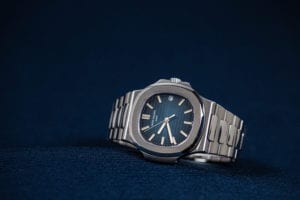Video Transcription
At a glance the Audemars Piguet Royal Oak and the Patek Philippe Nautilus seem to be distant cousins. They’re both stainless steel watches from two of the most esteemed watch brands, and they both have pretty unique case designs, but in reality they share much more. Both of these watches were designed by the late Gerald Genta. Now it’s rare to know the name of a watch designer, let alone that he created some of the most exclusive watches in the industry. So let’s take a look at how these two watches came to be, and our thoughts on which we prefer.
Royal Oak History

We’ll start with the Royal Oak. Like most Swiss brands at the time AP was reeling from the quartz crisis of the late 60s. With the majority of watch production now suddenly coming from Asia and not Switzerland a lot of Swiss watch brands were struggling. The simplicity and low cost of the quartz watch seemed to spell death for the antiquated mechanical watch. AP was looking for a home run to keep them going and prove the mechanical watch still had a place. Gerald Genta was approached by the marketing director of AP, and he was asked to design a water-resistant, unprecedented steel watch for the brand. The story goes Genta designed it in one day. Being inspired by a classic diver’s helmet. The eight screws on the octagonal bezel are instantly recognizable, and have since been copied by other brands. The watch also featured a labor-intensive tapessiere dial, as well as an integrated case design with an intricate bracelet. AP released the first Royal Oak referenced 5402 in 1972, and it was not well received. At 39 millimeters it was large for its time. Another deterrent: the cost. At the time it was ten times that of a Rolex Submariner, and people couldn’t understand how a stainless steel watch could cost more than one in precious metal. It became hard for AP to convey the high level of production necessary to produce this watch. It was clear the Royal Oak was ahead of its time, with avant-garde styling, a larger size, and the departure from precious metal. Maybe it was just fate, but in the midst of the quartz crisis, a stainless steel, oversized watch, with an outrageous price seemed to define what a luxury watch could be. Now anyone could have a watch that was accurate, but not everybody could have the Royal Oak. It is now the defining watch for AP, and probably what saved the brand during the quartz crisis.
Nautilus History

Just two years later in 1974 at Basel, Patek was looking to cash in on this shift in the industry. So they enlisted none other than Gerald Genta to create a new watch. History tells us, in true Genta fashion, he designed the Nautilus in five minutes, on a napkin, while watching Patek employees eat lunch. In 1976 Patek released the watch. Not only was the name of the Nautilus inspired by 20,000 Leagues Under the Sea, the design drew inspiration from the portholes of a submarine. The watch, like the Royal Oak, had a unique bezel and a unique dial. This time an embossed horizontal design. It also had another integrated bracelet. The case featured a unique hinge design that helped the watch achieve its 120 meter water resistance. And after the Royal Oak drew such backlash for being so big the Nautilus pushed the envelope again with its 43 millimeter size. It’s hard to miss the visual similarities of these two watches especially coming from two of the more esteemed brands and in such a short period of time, and the fact that they have essentially remained unchanged over the past 50 years speaks to the transcendent design of the both of them.
It’s What’s on the Inside that Counts
What is not so easy to see is what’s going on on the inside, and we find this especially interesting. Amid the quartz crisis, with brands struggling to survive, two of the most recognizable watches of the century are released, and believe it or not they’re powered by essentially the same movement! In 1967 JLC partnered with AP, Patek, and Vacheron to design an ultra-thin automatic movement. What came from that was the JLC Caliber 920, which AP then modified into the Caliber 2121 inside the Royal Oak, while Patek modified it into the Caliber 28-255 inside the original Nautilus. Now Genta went on to design other watches like the IWC Ingenieur, the Cartier Pasha, and the Bulgari Bulgari, but without contest the Royal Oak and the Nautilus were his crowning achievements. Both watches still remain into production to this day.
Royal Oak Ref. 15500
Here we’re looking at the Royal Oak 15500. It features an updated dial design, and an all-new in-house caliber 4302. Now beating at four Hertz and with a 70 hour power reserve it feels like a modern movement. This Royal Oak is also 41 millimeters. Now some AP purists will say the only Royal Oak is the 15202 with the original 2121 movement, but we feel this is a great modern interpretation of the watch that retains all of the hallmarks of the original.
Nautilus 5711

Now in comparison we have the Patek 5711. This watch has seen a few updates over the years and is now composed of a more traditional three-piece case design. The movement is the caliber 324 S C, which is probably the single biggest ding on the watch. It has only a 45 hour power reserve and non hacking seconds, which means the seconds hand doesn’t stop while the crown is in the setting position. And interestingly enough in early 2019 Patek, without much fanfare, updated the movement to the caliber 26-330 S C. This new caliber was essentially the same as before, but now with a hacking seconds hand. And as a note the original Royal Oak and Nautilus didn’t even feature second hands.
So Which is Best?
So if this was my decision, and I could only pick one, my vote would be the Nautilus. The Nautilus just has that extra something that can’t be defined. I like to think that Genta got it right the second time around. The overall design of the Nautilus just works better. The case mixes smooth curves into the angles and this juxtaposition is just so well executed, and then moving to the dial: one look at the sharp horizontal lines with its gradient and I’m sold. And this is really just a personal preference, but I feel like Patek thought about the ergonomics of the watch on the wrist, and to me it just seems to wear better. And lastly, from a pure investment standpoint, the Nautilus is in such high demand that it’s actually fetching a premium in the pre-owned market. Now the Royal Oak has done a better job sticking with its roots. The Royal Oak “Jumbo” Extra-Thin is still in production and retains the original 2121 movement, and the angular case of the Royal Oak is executed flawlessly, but it just doesn’t seem to hug the wrist as nicely as the Patek. And I can fully appreciate the immense level of manufacturing and care that goes into the Royal Oak Tapisserie dial I just prefer the gradient dial on the Nautilus. So if you want one of Gerald Genta’s best designs than the Royal Oak or the Nautilus is right up your alley, but if you want THE Genta watch then it has to be the Nautilus. Let us know your thoughts and thanks for watching.
Get More Articles Like This in Your Inbox
We're constantly creating great content like this. So, why not get it delivered directly to your inbox? By subscribing you agree to our Privacy Policy but you can unsubscribe at any time.






